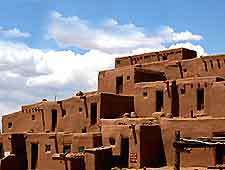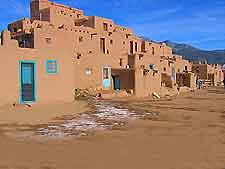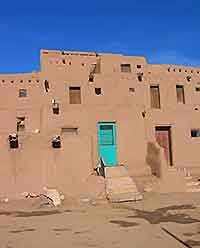Taos History Facts and Timeline
(Taos, New Mexico - NM, USA)

A popular draw for artists today, Taos has a long history, with its 1,000-year-old Pueblo still standing. It was home to Tiwa Native Americans for centuries before being colonized by the Spanish, won by the Mexicans and ceded to the US.
These days, there's a new town and a ski area, as well as the ancient village, plus a whole lot of art galleries and an inviting vibe.
Taos Pueblo and Europeans
Taos Pueblo, the original village located just north of the main town and plaza, was first set up about 1,000 years ago, making it America's oldest inhabited community. It is made up of many homes and is five storeys high in places, with narrow lanes. Taos Pueblo became a UNESCO World Heritage site in 1992.
An artillery captain under Spanish conquistador Francisco Vasquez de Coronado, Hernando de Alvarado arrived in the Taos Valley in 1540, although history in Taos wasn't officially established until 1615, after the Spanish usurped the Pueblo villages. Things were calm at first, until the Indians revolted in 1640 and killed a priest. They fled, but returned in 1661 and joined the Pueblo Revolt in 1680.

The Spanish returned in 1692, although the Taos Pueblo community continued to resist the colonialists until they were defeated at Taos Canyon in 1696. The Comanche also had issues with the Spanish until the New Mexico provincial governor, Juan Bautista de Anza, routed them in 1779.
Statehood to Art Colony
Taos first went to the Mexicans in the Mexican War of Independence, before the region was signed over to the USA in 1848, following the Mexican-American War. Shortly after, the Taos revolt pitted the Hispanics and Native Americans against the US, leading to the death of Governor Charles Bent, whose house is today a popular landmark. In 1912, New Mexico received statehood and
Santa Fe became its capital.

Many artists became a part of local history from around the turn of the 19th century, forming the Taos Society of Artists in the year of 1915. They painted Native Americans scenes, some of which reside in the Taos Art Museum, while the Harwood Museum of Art has paintings from the 18th century. The Millicent Rogers Museum - for Indian art and crafts, the homes of Ernest Blumenschein and Martinez Hacienda, and the Kit Carson Museum are other places of note. Many galleries reside in the Ranchos de Taos area, to the south of the town, although this district is best known for its amazing San Francisco de Asis Church.
The 1900s and Today
The town was incorporated in 1934 and its main street, the Paseo del Pueblo, was built up fast with hotels and other businesses. The nearby Taos Ski Valley was set up in 1956 and the lofty Gorge Bridge was finished in 1965.
The neighboring hippie-centric Arroyo Hondo was a prominent local feature established in 1967, while the US government returned Blue Lake to Taos Pueblo in 1970. Today cultures live together harmoniously in Taos and this remains a town fiercely proud of its history.
 A popular draw for artists today, Taos has a long history, with its 1,000-year-old Pueblo still standing. It was home to Tiwa Native Americans for centuries before being colonized by the Spanish, won by the Mexicans and ceded to the US.
A popular draw for artists today, Taos has a long history, with its 1,000-year-old Pueblo still standing. It was home to Tiwa Native Americans for centuries before being colonized by the Spanish, won by the Mexicans and ceded to the US. The Spanish returned in 1692, although the Taos Pueblo community continued to resist the colonialists until they were defeated at Taos Canyon in 1696. The Comanche also had issues with the Spanish until the New Mexico provincial governor, Juan Bautista de Anza, routed them in 1779.
The Spanish returned in 1692, although the Taos Pueblo community continued to resist the colonialists until they were defeated at Taos Canyon in 1696. The Comanche also had issues with the Spanish until the New Mexico provincial governor, Juan Bautista de Anza, routed them in 1779. Many artists became a part of local history from around the turn of the 19th century, forming the Taos Society of Artists in the year of 1915. They painted Native Americans scenes, some of which reside in the Taos Art Museum, while the Harwood Museum of Art has paintings from the 18th century. The Millicent Rogers Museum - for Indian art and crafts, the homes of Ernest Blumenschein and Martinez Hacienda, and the Kit Carson Museum are other places of note. Many galleries reside in the Ranchos de Taos area, to the south of the town, although this district is best known for its amazing San Francisco de Asis Church.
Many artists became a part of local history from around the turn of the 19th century, forming the Taos Society of Artists in the year of 1915. They painted Native Americans scenes, some of which reside in the Taos Art Museum, while the Harwood Museum of Art has paintings from the 18th century. The Millicent Rogers Museum - for Indian art and crafts, the homes of Ernest Blumenschein and Martinez Hacienda, and the Kit Carson Museum are other places of note. Many galleries reside in the Ranchos de Taos area, to the south of the town, although this district is best known for its amazing San Francisco de Asis Church.